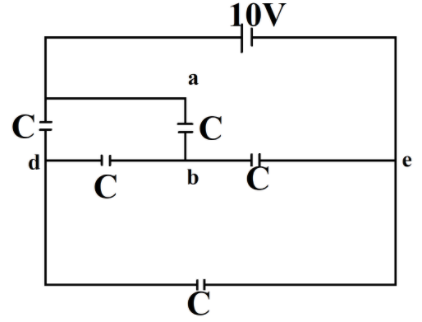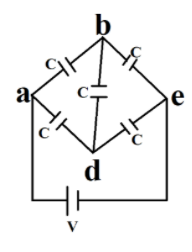
What is the energy stored in the capacitor between the terminals a and b of the network shown in the figure?
Capacitance of each capacitor

A.
B. Zero
C.
D.

Answer
489k+ views
1 likes
Hint: If you look closely at the diagram, you will notice that there is a wheatstone network in here. It is a balanced Wheatstone network. So, it can easily be solved using the concept of a wheatstone bridge. In a balanced Wheatstone Bridge, It is said that both sides of the parallel bridge network are balanced since the voltage at point C is equal to the voltage at point D, with zero being the difference.
Formula used:
For solving this question, we will be using the formula
Q = CV
Step by step solution:
First, let us redraw the diagram to make it a Wheatstone network
Now, Applying the concept of the balanced Wheatstone bridge,
Now, The Charge on capacitor between the terminals a and b

Now, for the energy stored in the capacitor between a and b,
Now, using
Q = CV
We have
Now, as
And, V = 10 V
Takin the given values,
So, the energy stored in the capacitor between the terminals a and b of the network shown in the figure will be
Note:
The network (or bridge) of Wheatstone is a circuit for indirect resistance calculation by a null reference approach relative to an established normal resistance. It consists of four R1, R2, R3 and R4 resistors connected to a quadrilateral ABCD. The Wheatstone bridge was created by the British Scientist, mathematician and physicist, Samuel Hunter Christie in 1843.
Formula used:
For solving this question, we will be using the formula
Q = CV
Step by step solution:
First, let us redraw the diagram to make it a Wheatstone network
Now, Applying the concept of the balanced Wheatstone bridge,
Now, The Charge on capacitor between the terminals a and b

Now, for the energy stored in the capacitor between a and b,
Now, using
Q = CV
We have
Now, as
And, V = 10 V
Takin the given values,
So, the energy stored in the capacitor between the terminals a and b of the network shown in the figure will be
Note:
The network (or bridge) of Wheatstone is a circuit for indirect resistance calculation by a null reference approach relative to an established normal resistance. It consists of four R1, R2, R3 and R4 resistors connected to a quadrilateral ABCD. The Wheatstone bridge was created by the British Scientist, mathematician and physicist, Samuel Hunter Christie in 1843.
Recently Updated Pages
Master Class 11 Economics: Engaging Questions & Answers for Success

Master Class 11 Business Studies: Engaging Questions & Answers for Success

Master Class 11 Accountancy: Engaging Questions & Answers for Success

Master Class 11 English: Engaging Questions & Answers for Success

Master Class 11 Computer Science: Engaging Questions & Answers for Success

Master Class 11 Maths: Engaging Questions & Answers for Success

Trending doubts
Why is steel more elastic than rubber class 11 physics CBSE

Explain why a There is no atmosphere on the moon b class 11 physics CBSE

In northern hemisphere 21st March is called as A Vernal class 11 social science CBSE

Balance the equation KOH + H2SO4 to K2SO4 + H2O class 11 chemistry CBSE

Find the missing frequency in the following distribution class 11 maths CBSE

The term metabolism refers to A Release of energy B class 11 biology CBSE




